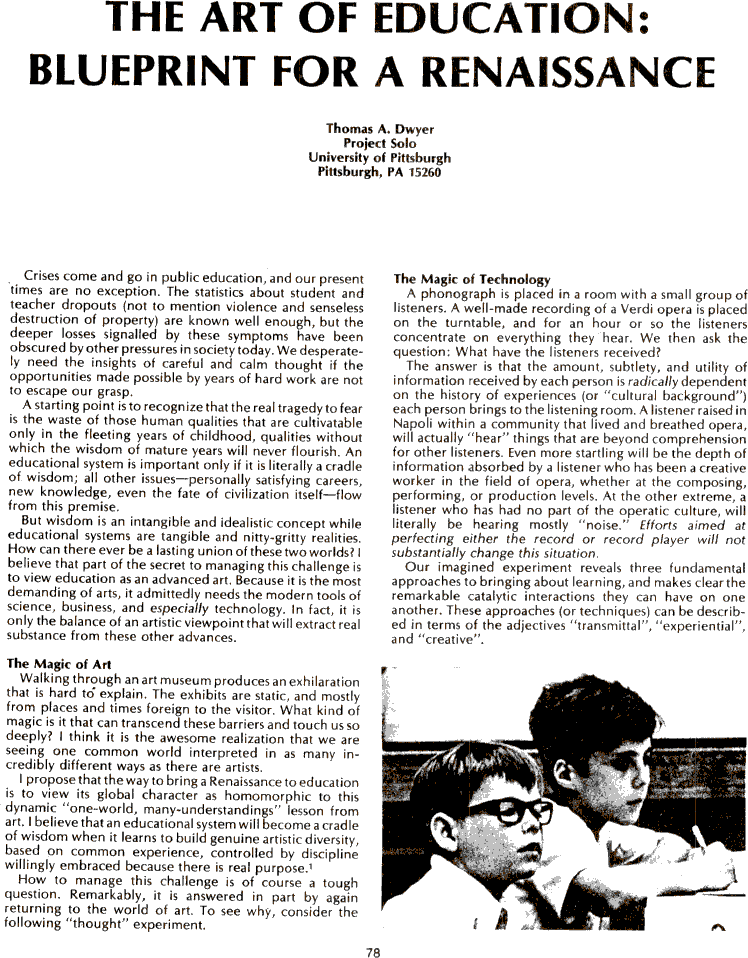by Thomas A. Dwyer

THE ART OF EDUCATION: BLUEPRINT FOR A RENAISSANCE Thomas A. Dwyer Project Solo University of Pittsburgh Pittsburgh, PA 15260 Crises come and go in public education, and our present times are no exception. The statistics about student and teacher dropouts (not to mention violence and senseless destruction of property) are known well enough, but the deeper losses signalled by these symptoms have been obscured by other pressures in society today. We desperately need the insights of careful and calm thought if the opportunities made possible by years of hard work are not to escape our grasp. **** A starting point is to recognize that the real tragedy to fear is the waste of those human qualities that are cultivatable only in the fleeting years of childhood, qualities without which the wisdom of mature years will never flourish. An educational system is important only if it is literally a cradle of wisdom; all other issues-personally satisfying careers, new knowledge, even the fate of civilization itself-flow from this premise. **** But wisdom is an intangible and idealistic concept while educational systems are tangible and nitty-gritty realities.How can there ever be a lasting union of these two worlds? I believe that part of the secret to managing this challenge is to view education as an advanced art. Because it is the most demanding of arts, it admittedly needs the modern tools of science, business, and especially technology. In fact, it is only the balance of an artistic viewpoint that will extract real substance from these other advances. **** The Magic of Art Walking through an art museum produces an exhilaration that is hard to explain. The exhibits are static, and mostly from places and times foreign to the visitor. What kind of magic is it that can transcend these barriers and touch us so deeply? I think it is the awesome realization that we are seeing one common world interpreted in as many incredibly different ways as there are artists. **** I propose that the way to bring a Renaissance to education is to view its global character as homomorphic to this dynamic "one-world, many-understandings" lesson from art. I believe that an educational system will become a cradle of wisdom when it learns to build genuine artistic diversity, based on common experience, controlled by discipline willingly embraced because there is real purpose.1 **** How to manage this challenge is of course a tough question. Remarkably, it is answered in part by again returning to the world of art. To see why, consider the following "thought" experiment. **** The Magic of Technology A phonograph is placed in a room with a small group of listeners. A well-made recording of a Verdi opera is placed on the turntable, and for an hour or so the listeners concentrate on everything they hear. We then ask the question: What have the listeners received? **** The answer is that the amount, subtlety, and utility of information received by each person is radically dependent on the history of experiences (or "cultural background")each person brings to the listening room. A listener raised in Napoli within a community that lived and breathed opera, will actually "hear" things that are beyond comprehension for other listeners. Even more startling will be the depth of information absorbed by a listener who has been a creative worker in the field of opera, whether at the composing, performing, or production levels. At the other extreme, a listener who has had no part of the operatic culture, will literally be hearing mostly "noise." Efforts aimed at perfecting either the record or record player will not substantially change this situation. **** Our imagined experiment reveals three fundamental approaches to bringing about learning, and makes clear the remarkable catalytic interactions they can have on one another. These approaches (or techniques) can be described in terms of the adjectives "transmittal", "experiential", and "creative".

